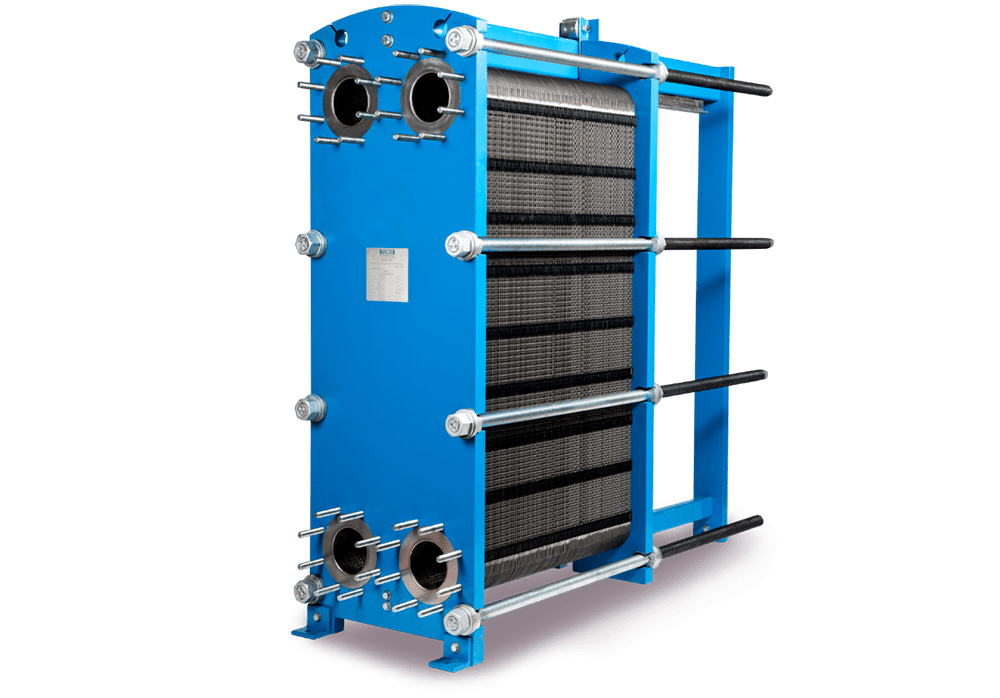Plate heat exchangers (PHEs) are a type of compact heat exchanger designed to transfer heat efficiently between two fluids. They are made up of multiple thin, slightly separated plates that have large surface areas and fluid flow passages for heat transfer.
Unlike traditional shell-and-tube heat exchangers, plate heat exchangers provide superior heat transfer performance in a much smaller footprint, making them a preferred choice for industries where space, energy efficiency, and flexibility are essential.
These exchangers are widely used in HVAC, chemical processing, pharmaceuticals, food & beverage, marine, power plants, and refrigeration systems due to their high efficiency and ease of customization.
Working Principle
The working of a plate heat exchanger is based on the principle of indirect heat transfer through a conductive barrier (the plate). Here’s how it works:
- Fluids enter the exchanger from opposite ends and flow through alternating channels formed between the plates.
- Each plate has a corrugated pattern (chevron or herringbone) to increase turbulence and heat transfer efficiency.
- The plates are arranged in such a way that hot and cold fluids flow in counter-current or parallel flow, depending on the design.
- Heat is transferred from the hot fluid to the cold fluid through the plate material (typically stainless steel or titanium), without the two fluids ever mixing.
- Gaskets, brazing, or welding ensure fluid separation and guide the flow properly.
Types of Plate Heat Exchangers
- Gasketed Plate Heat Exchangers
- Plates are sealed using elastomeric gaskets
- Easy to disassemble, clean, and maintain
- Ideal for applications where fluids may require periodic inspection
- Brazed Plate Heat Exchangers
- Plates are permanently joined by brazing (usually copper or nickel)
- Compact, sealed, and maintenance-free
- Suitable for refrigeration, HVAC, and high-pressure applications
- Welded Plate Heat Exchangers
- Plates are welded together to eliminate gaskets
- Handles high temperature and aggressive fluids
- Used in chemical and oil & gas industries
- Semi-Welded Plate Heat Exchangers
- Combination of welded and gasketed designs
- Suitable for applications with corrosive fluids on one side
Advantages of Plate Heat Exchangers
- High Heat Transfer Efficiency due to large surface area and turbulent flow
- Compact Size: Smaller footprint than shell-and-tube types
- Ease of Maintenance: Gasketed types can be opened easily for cleaning
- Modular Design: Plates can be added or removed to change capacity
- Low Fouling Risk: Corrugations promote self-cleaning action
- Quick Response Time: Faster heat exchange due to thin plate material
- Lower Liquid Volume: Minimizes thermal mass and improves control
Limitations
- Not suitable for fluids containing large particles (risk of clogging)
- Gaskets may degrade over time with certain chemicals or high temps
- Brazed types are not serviceable and must be replaced if fouled
- Pressure and temperature limitations depending on model and design
Plate heat exchangers are a cornerstone of modern thermal engineering. Their efficiency, compactness, and design flexibility make them indispensable across industries. Whether you’re managing a commercial HVAC system, optimizing a food production line, or operating a chemical processing unit, plate heat exchangers deliver reliable, high-performance heat transfer.
With many variants—gasketed, brazed, welded, and semi-welded—they can be tailored to meet virtually any application. Proper selection, maintenance, and operation ensure these devices provide long service life, lower energy costs, and consistent performance.
